-
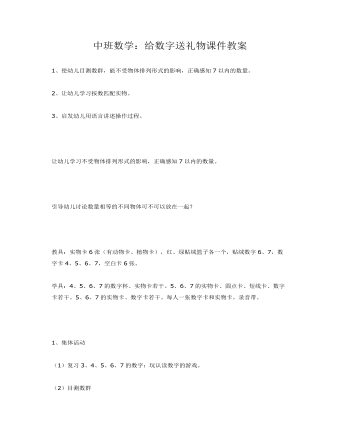
中班数学:给数字送礼物课件教案
2、让幼儿学习按数匹配实物。3、启发幼儿用语言讲述操作过程。让幼儿学习不受物体排列形式的影响,正确感知7以内的数量。引导幼儿讨论数量相等的不同物体可不可以放在一起?
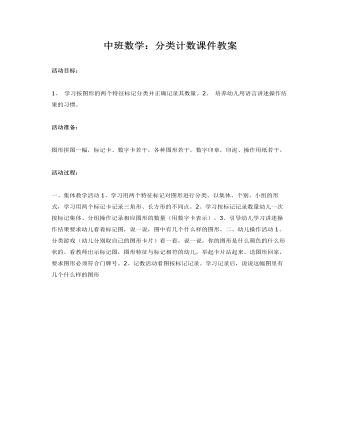
中班数学:分类计数课件教案
2、培养幼儿用语言讲述操作结果的习惯。活动准备: 图形拼图一幅,标记卡、数字卡若干,各种图形若干,数字印章,印泥、操作用纸若干。
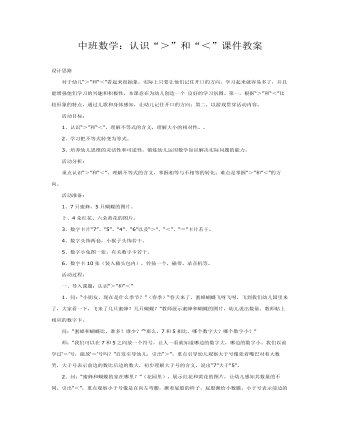
中班数学:认识“>”和“<”课件教案
活动目标:1、认识“>”和“<”,理解不等式的含义,理解大小的相对性。。2、学习把不等式转变为等式。3、培养幼儿思维的灵活性和可逆性,锻炼幼儿运用数学知识解决实际问题的能力。 活动分析: 重点认识“>”和“<”,理解不等式的含义,掌握相等与不相等的转化;难点是掌握“>”和“<”的方向。 活动准备:1、7只蜜蜂,5只蝴蝶的图片。 2、4朵红花、六朵黄花的图片。3、数字卡片“7”、“5”、“4”、“6”以及“>”、“<”、“=”卡片若干。4、数字头饰两套,小猴子头饰若干。5、数字小兔图一张,有关数字卡若干。6、数字卡10张(装入猫头包内),铃鼓一个,磁带、录音机等。
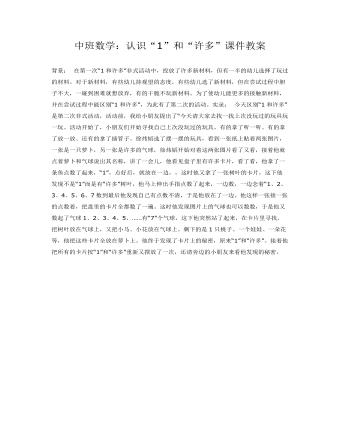
中班数学:认识“1”和“许多”课件教案
实录: 今天区别“1和许多”是第二次非式活动,活动前,我给小朋友提出了“今天请大家去找一找上次没玩过的玩具玩一玩。活动开始了,小朋友们开始寻找自己上次没玩过的玩具。有的拿了听一听、有的拿了放一放、还有的拿了插管子。徐炜韬选了摆一摆的玩具,看到一张纸上贴着两张图片,一张是一只萝卜,另一张是许多的气球,徐炜韬开始对着这两张图片看了又看,接着他就点着萝卜和气球说出其名称,讲了一会儿,他看见盘子里有许多卡片,看了看,他拿了一条鱼点数了起来,“1”,点好后,就放在一边,,这时他又拿了一张树叶的卡片,这下他发现不是“1”而是有“许多”树叶,他马上伸出手指点数了起来,一边数,一边念着“1、2、3、4、5、6、7数到最后他发现自己有点数不清,于是他放在了一边。
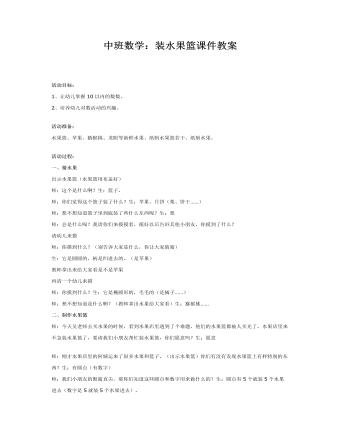
中班数学:装水果篮课件教案
2、培养幼儿对数活动的兴趣。活动准备:水果篮、苹果、猕猴桃、龙眼等新鲜水果、纸制水果篮若干、纸制水果。活动过程:一、猜水果出示水果篮(水果篮用布盖好)师:这个是什么啊?生:篮子。师:你们觉得这个篮子装了什么?生:苹果、月饼(梨、饼干……)师:想不想知道篮子里到底装了些什么东西呢?生:想师:会是什么呢?我请你们来摸摸看,摸好以后告诉其他小朋友,你摸到了什么?请幼儿来摸师:你摸到什么?(别告诉大家是什么,你让大家猜猜)生:它是圆圆的,柄是凹进去的。(是苹果)教师拿出来给大家看是不是苹果再请一个幼儿来摸师:你摸到什么?生:它是椭圆形的,毛毛的(是橘子……)师:想不想知道是什么啊?(教师拿出水果给大家看)生:猕猴桃……
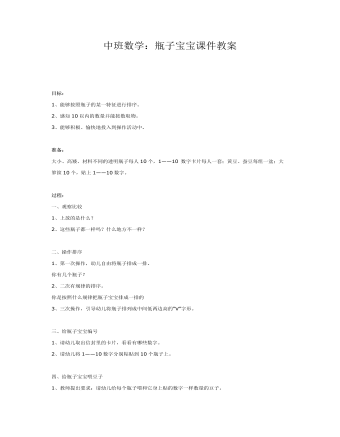
中班数学:瓶子宝宝课件教案
2、感知10以内的数量并能按数取物。3、能够积极、愉快地投入到操作活动中。 准备:大小、高矮、材料不同的透明瓶子每人10个,1——10 数字卡片每人一套;黄豆、蚕豆每组一盆;大箩筐10个,贴上1——10数字。 过程:一、观察比较1、上放的是什么?2、这些瓶子都一样吗?什么地方不一样? 二、操作排序1、第一次操作,幼儿自由将瓶子排成一排。你有几个瓶子?2、二次有规律的排序。你是按照什么规律把瓶子宝宝排成一排的3、三次操作,引导幼儿将瓶子排列成中间低两边高的“V”字形。
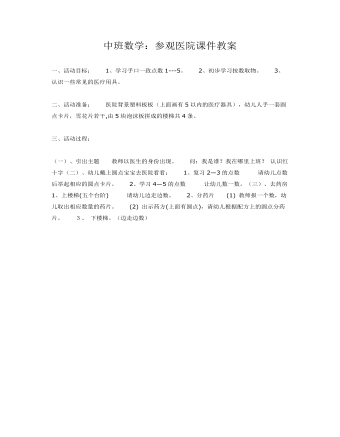
中班数学:参观医院课件教案
二、活动准备: 医院背景塑料板板(上面画有5以内的医疗器具),幼儿人手一套圆点卡片,雪花片若干,由5块泡沫板拼成的楼梯共4条。三、活动过程:(一)、引出主题 教师以医生的身份出现。 问:我是谁?我在哪里上班?认识红十字(二)、幼儿戴上圆点宝宝去医院看看: 1、复习2—3的点数 请幼儿点数后举起相应的圆点卡片。
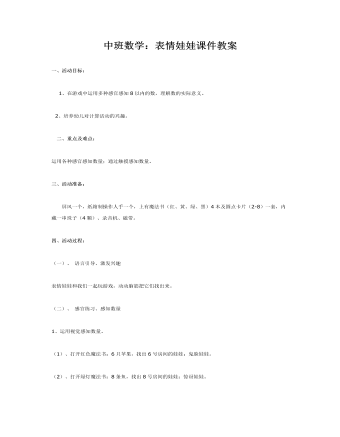
中班数学:表情娃娃课件教案
2、培养幼儿对计算活动的兴趣。 二、重点及难点: 运用各种感官感知数量;通过触摸感知数量。 三、活动准备: 屏风一个,纸箱制操作人手一个,上有魔法书(红、黄、绿、黑)4本及圆点卡片(2-8)一套,内藏一串珠子(4颗)、录音机、磁带。 四、活动过程: (一)、语言引导、激发兴趣 表情娃娃和我们一起玩游戏,动动脑筋把它们找出来。
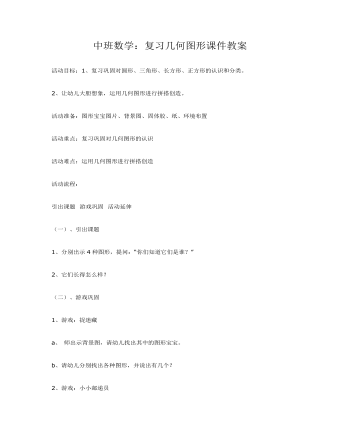
中班数学:复习几何图形课件教案
2、让幼儿大胆想象,运用几何图形进行拼搭创造。活动准备:图形宝宝图片、背景图、固体胶、纸、环境布置活动重点:复习巩固对几何图形的认识活动难点:运用几何图形进行拼搭创造活动流程:引出课题 游戏巩固 活动延伸
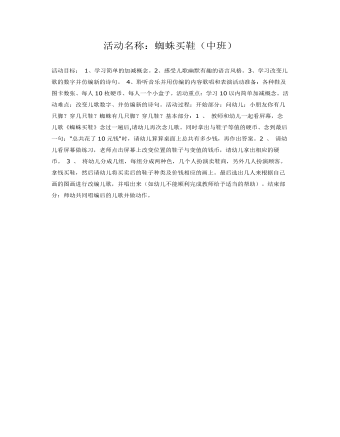
中班数学:《蜘蛛买鞋》课件教案
2、感受儿歌幽默有趣的语言风格。3、学习改变儿歌的数字并仿编新的诗句。 4、聆听音乐并用仿编的内容歌唱和表演活动准备:各种鞋及图卡数张、每人10枚硬币、每人一个小盒子。活动重点:学习10以内简单加减概念。活动难点:改变儿歌数字、并仿编新的诗句。活动过程:开始部分:问幼儿:小朋友你有几只脚?穿几只鞋?蜘蛛有几只脚?穿几鞋?基本部分:1 、教师和幼儿一起看屏幕,念儿歌《蜘蛛买鞋》念过一遍后,请幼儿再次念儿歌。同时拿出与鞋子等值的硬币、念到最后一句:"总共花了10元钱"时,请幼儿算算桌面上总共有多少钱,再作出答案。
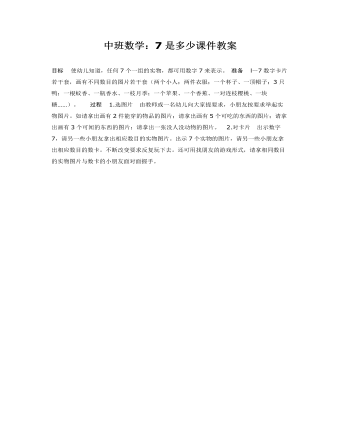
中班数学:7是多少课件教案
准备 l~7数字卡片若干套,画有不同数目的图片若干套(两个小人;两件衣服;一个杯子、一顶帽子;3只鸭;一根蚊香、一瓶香水、一枝月季;一个苹果、一个香蕉、一对连枝樱桃、一块糖……)。
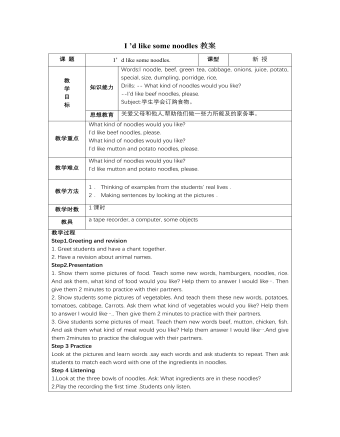
人教版新目标初中英语七年级下册I ’d like some noodles教案
教学过程Step 1: warming-up Sing a song---------“food and drink” Step 2: Revision1 Dictation2 Revise: What kind of noodles would you like?I’d like …What size bowl of noodles would you like?I’d like…Step 3: Presentation1 show pictures of food, ask students say the words.2 Students read the newspaper ad in 3a. Fill in blanks with words in the box. Then read the ad together, the teacher explains some difficult language points.3 Check the answers Step 4 PracticeAsk students to finish 3b in the same way according to 3a. Students read the short passage and fill in the blanks .At last, check the answers.Step 5 productionAsk students to write their own ad for dumplings, noodles, drinks, and other foods they know. Then ask students to read their partner’s ad. Then order food and drink from their partner.Step 6 Home workGroup work – make an ad about “food and drink”
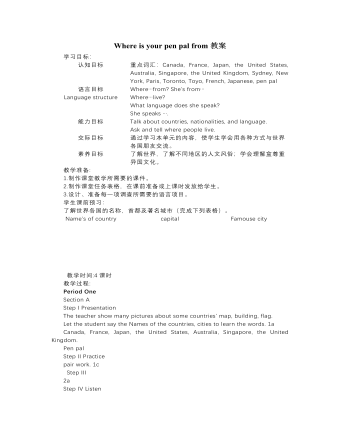
人教版新目标初中英语七年级下册Where is your pen pal from教案
2.1Match the country with the language.Step II Reading3a? let the students read the letter fast and answer the questions.? Let the students ask more questions about the letter as possible as the can.Step III Writing3b.Step IV. Pairwork2cStep V Listening2a, 2bStep V. HomeworkExercises book(1) P3Exercises book (2) P3Period FourStep I . Dictate the words and sentences in Unit1.Step II. Self-checkStep III. Check the answers for Exercises book in the unit.Step IV. Home workRevise and preparation for unit 2.教学反思:通过本单元的学习,学生基本可以谈论人们的国籍,居住城市及其所说的语言,通过书信方式去介绍自己并寻找笔友。但在涉及到国外的一些城市时,学生对这方面的知识相对欠缺,能介绍的城市并不多,也反应出学生课前预习不充分,这跟学生学习条件也有关,大多数学生无法通过网络获取所需信息。因此,在以后的教学中要多指导学生通过计算机网络获取信息,拓宽知识面。
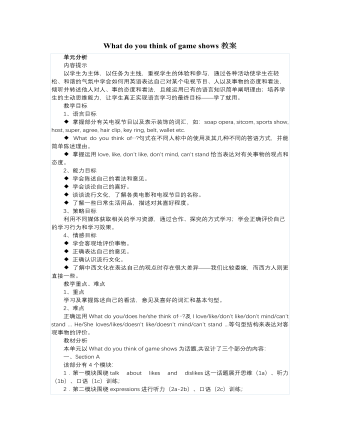
人教版新目标初中英语七年级下册What do you think of game shows教案
五、教学Section B-2c1. Pair work: What do you think of the belt/sunglasses/…? What does your father/mother/… think of your scarf/belt…?2. Group work(1). Teacher shows some different kinds of school uniforms (制服)and asks : “ What do you think of your school uniforms? If you have a chance to choose your school uniforms, what kind would you like to choose?”(2). Discuss in groups.(3).Get some Ss to report in class.说明:这一步旨在让学生运用已有的语言知识谈论对事物的看法和意见,并简单阐明理由,培养学生的主动思维能力和运用英语的能力。六、教学拓展调查电视节目的收视率任务:调查你周围的人对现在各种电视节目的反响。活动过程:1.教师布置任务,让学生调查周围的人(包括他的亲戚朋友和邻居)喜欢收看哪方面的电视节目。2.学生进行调查活动,运用本单元所学的句型What do you think of….? (Why?)What's your favorite game shows?What do you think of talk show?I doesn’t mind it.I like it.I love it.I can’t stand it.3.记录下排在前10位的TV Program,填写调查表,比较其收视率。
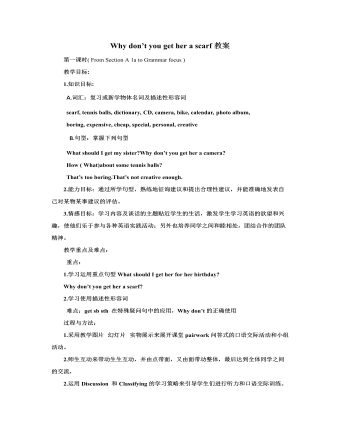
人教版新目标初中英语八年级下册Why don’t you get her a scarf教案
教师带领学生复习有关描述宠物的词汇,采用教师提问学生回答的方进行。如:T:What animals do you think would be good pets?What animals do you think would be bad pets?What do you think are good animals for a six-year-old child?然后学生进行 pairwork 练习。Task two: 师生互动,学习探究 1、播放3a部分的录音,引导学生一边听录音,一边跟读。2、通过听录音学生回答以下问题:Why do you think pot-bellied pigs are popular?What are the advantages and disadvantages of keeping such a pet?教师对学生的回答进行及时点评。3.学习范文,学习重点短语,为下步的模仿写作提供语言素材。T :1. )Have you ever kept a pig as a pet?Do you like pigs? St.:No.…Why don’t you like to keep a pig? St: No.They’re too dirty and lazy(Do you know in some foreign countries like Hollyland, Australia,pigs are the most popular pet.there’s a kind of pig.(图)it has an interesting name? it ‘s called a pot-bellied pig.) Now,let’s learn an article about this kind of interesting pet.2.)play the tapeSt.:Listen and repeat3.)show some Qs on computer(本子St.: read silently,then answerthe Qs(本子)4.)Ask ss. Close book and retell this passage.(what is a pot-bellied pig? Is it a good or bad pet? ) St.: retell it to each other“A pot –bellied pig is a popular pet now…”5.read the article together.St.:.practice reading
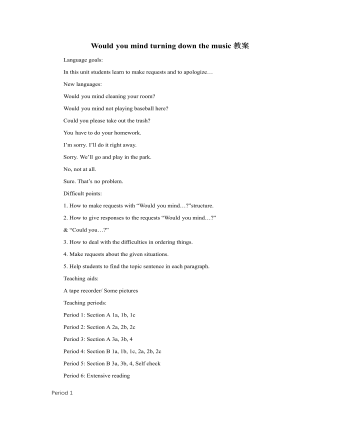
人教版新目标初中英语八年级下册Would you mind turning down the music教案
Step 4. Group work (4)1. Ask a pair of students to read the dialogue. Say, This activity provides speaking, listening and writing practice using the target language.2. Ask students to complete the work in groups.3. Check the answers with the whole class. 4. Explain some of the language points. Step 5. Word review (Self check 1)1. Ask students to read the words and the phrases given. 2. Fill in the blanks with proper forms of these words to complete the sentences. 3. Check the answers with the whole class. Homework:Do activity 2 on page 57 after class. Period 6Teaching aims: 1. Teach vocabulary words and the useful expressions. 2. Enable the students to learn etiquette in different culture. 3. Help the students learn how to behave politely in public places and in daily life. Teaching procedures:Step 1. RevisionHelp students to review the function of making requests through a free talk. Then lead them to the topic of etiquette. Explain the meaning of etiquette. Or, ask students to look it up in the dictionary. Step 2. Pre-reading (Section 1)1. Ask students to read the picture and make a list with their partner about how many rules of etiquette can be seen being broken.
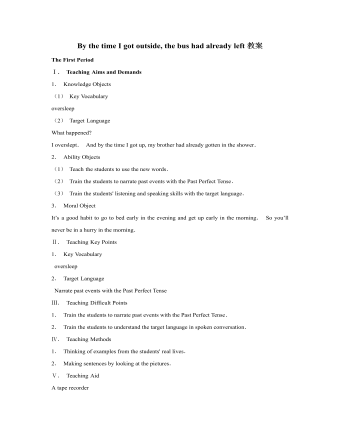
人教版新目标初中英语九年级下册By the time I got outside, the bus had already left教案
Ⅰ. Teaching Aims and Demands1. Knowledge Objects(1) Key Vocabularyoversleep(2) Target LanguageWhat happened?I overslept. And by the time I got up, my brother had already gotten in the shower.2. Ability Objects(1) Teach the students to use the new words.(2) Train the students to narrate past events with the Past Perfect Tense.(3) Train the students' listening and speaking skills with the target language.3. Moral ObjectIt’s a good habit to go to bed early in the evening and get up early in the morning. So you’ll never be in a hurry in the morning.Ⅱ. Teaching Key Points1. Key Vocabularyoversleep2. Target LanguageNarrate past events with the Past Perfect TenseⅢ. Teaching Difficult Points1. Train the students to narrate past events with the Past Perfect Tense.2. Train the students to understand the target language in spoken conversation.Ⅳ. Teaching Methods1. Thinking of examples from the students' real lives.2. Making sentences by looking at the pictures.Ⅴ. Teaching AidA tape recorderⅥ. Teaching ProceduresStep I Revision1. Revise the language points in Unit 8.Ask some questions like this: What volunteer work would you like to do?Help the students to answer, I’d like to…/I love to…/I hope to2. Practice the dialogue in Activity 3c on page 62 again. Get students to role play the similar dialogues with the following.
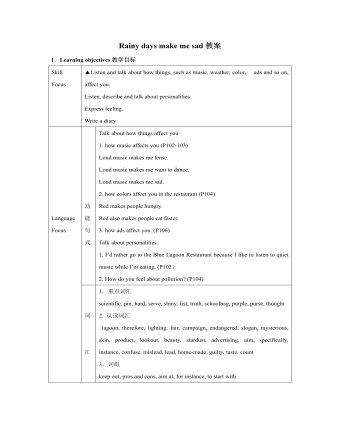
人教版新目标初中英语九年级下册Rainy days make me sad教案
1. 教材分析本单元以how do things affect you?为话题, 从颜色、天气、音乐、广告、产品等方面谈论了外界事物如何影响人的心情。要求学生掌握表达某物或某事给人带来的感觉、看法或影响等。共设计了四个部分的内容:Section A 该部分有4个模块:第一模块围绕Which restaurant would you like to go to?这一话题展开思维(1a)、听力(1b)、口语(1c)训练;第二模块围绕How does music affect you? 进行听力(2a-2b)、口语训练(2c);第三模块继续围绕how do colors in the restaurant affect you这一话题展开训练,训练形式为阅读和问题体验(3a)和小组活动(3b);第四模块仍就How do things affect you这一话题以调查的形式展开讨论。Section B该部分有4个模块:第一模块围绕产品广告对人们的影响这一话题以“配对”(1a)与“列举”(1b)两种形式展开训练;第二模块继续围绕How do things affect you? 进行听力(2a-2b)、口语对话训练(2c);第三模块围绕“Advertising”这一话题展开阅读(3a-3b)和写作(3c)训练;第四模块围绕How posters affect you这一话题以口语训练形式展开小组活动。
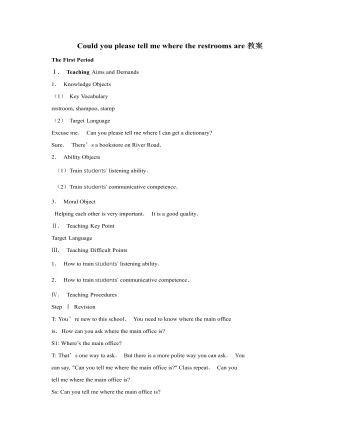
人教版新目标初中英语九年级下册Could you please tell me where the restrooms are教案
Step Ⅰ RevisionCheck homework. Ask a few students to read the article in 3a.Then ask a few students to read their guides.Step Ⅱ Part 1Look at the words in the box. Ask a student to read them. Make sure the students understand the meaning of the words. You are to fill in the blanks with the words. In some cases, students may need to use another form of the word, for example adjusting for tense or subject/ verb agreement.Ask students to fill in the blanks on their own.Check the answers. Step ⅢPart 2Go through the instructions with the class.Look at the example with the students.Ask students what the answer would be.Ask a student to read the question and answer it.Excuse me, could you tell me where the bank is, please?The bank is across the street from the shopping malt.Get students to complete the work in pairs.Check the answers. Ask a few students to read their questions.Step Ⅳ Just for Fun!Ask all the students to read the conversation. Ask: What is funny about this cartoon? Help students to explain. A Martian is a person from the planet Mars.There is no such thing as Martian food on Earth, and the clerk looks silly because he is trying to think of where there is a Martian restaurant.Invite some pairs of students to present this conversation to the rest of the class.Step Ⅴ Summary and HomeworkIn this class, we’ve done much writing practice using the key vocabulary words and the target language presented in this unit. After class, please finish the questions in 2 in your exercise books. Then finish the exercises on pages 47~48 of the workbook as well.The Seventh Period Ⅰ Teaching Aims and Demands1. Knowledge Objects(1) Key Vocabularyimage, adventure, jealousy, hero, crime, journey, brave, no longer, show interest in, take it easy, become interested in, plain looks(2)Text:Grown-ups like cartoons, too.2. Ability Objects(1) Fast-reading to get a general idea of the text.(2) Careful-reading to get the detailed information in the text.
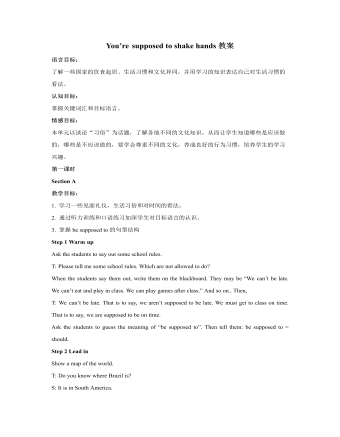
人教版新目标初中英语九年级下册You’re supposed to shake hands教案
教学目标:1. 掌握本单元一些重点词汇的写法和用法。2. 学会自如谈论餐桌礼仪。Step 1 RevisionAsk some students to retell the customs at the table in France in the passage in 3a.Step 2 Self checkPart 1. Fill in each bland with the correct word given. Students do the exercises by themselves at first. Then check the answers. Ask the students to comprehend the sentences and help them point out uses of some words, like “arrive (at / in) sw., spend time / money on sth , spend time / money (in) doing sth.”Part 2. Read about Fan Ling’s experience in a western restaurant. Understand the passage. Point out some key points in the passage.1. be / get used to doing sth. 习惯做某事2. begin with = start with 以….开头3. crowd v. 挤满,塞满 the crowd 人群 crowded adj. 拥挤的Then students discuss about how she would solve her problem. Ask some to share their stories with others.Part 3. Complete the crossword by looking at the sentences on the left. Then check the answers.

